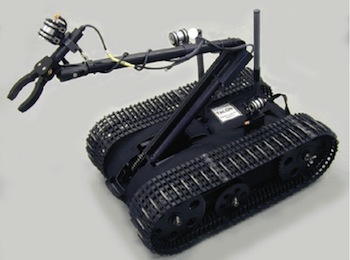Robots, robots everywhere, and they're even starting to think. Here's our round-up of the news about our coming robot overlor--we mean, servants--that has surfaced this week.
Robot catches a ball, hints at future butler powers
We've seen DLR's Justin robots before, but the German firm has been polishing the skills of its wheeled android, too. Now it's demonstrated just how clever Justin is getting--it can do all the identification, tracking, prediction and co-ordinated limb movements and ground-moves to catch a thrown ball. And, even better, it can catch two at once. The dynamic processing inside the bot needed to pull off the catches is very sophisticated--though your pliable human brain can do it with barely a second thought. Justin, however, can catch about 80% of the balls thrown its way--which may beat your score.
[youtube R6pPwP3s7s4]
The real purpose here is to improve the physical dexterity of robots like Justin for when they work in human environments. We can even see hints at future butler-like powers when Justin makes a cup of capsule coffee.
Fukushima gets more robotic help
 When disaster struck Japan's nuclear power facilities, the world more or less expected an army of robots to roll in, since Japan is notionally the 'bot central. But, for a number of reasons, this didn't happen--until two packbots arrived to sample radiation levels inside the shattered buildings of Fukushima. Now more robots are due to go in to help tackle matters. Two Talon robots, more commonly used in battlefield situations will be used to measure gamma radiation levels inside the site, making a contamination map using accurate GPS sensors. A Quince robot developed in Japan and designed to cope with rough terrain will help in spraying water into spent-fuel storage pools, a characteristic of the boiling water reactor design, and thus helping to cool and contain the fuel rods stored near the main reactors.
When disaster struck Japan's nuclear power facilities, the world more or less expected an army of robots to roll in, since Japan is notionally the 'bot central. But, for a number of reasons, this didn't happen--until two packbots arrived to sample radiation levels inside the shattered buildings of Fukushima. Now more robots are due to go in to help tackle matters. Two Talon robots, more commonly used in battlefield situations will be used to measure gamma radiation levels inside the site, making a contamination map using accurate GPS sensors. A Quince robot developed in Japan and designed to cope with rough terrain will help in spraying water into spent-fuel storage pools, a characteristic of the boiling water reactor design, and thus helping to cool and contain the fuel rods stored near the main reactors.
[youtube lGK-XxWS7Ms]
Don8r, another beggar bot
Just last week we wrote about DONA, an attempt to counteract charity donation fatigue with a tiny cute robot, and now it's emerged that the Red Riding-Hood lookalike is not alone--Don8r is a similar device.
It was developed by product design student Tim Pryde in Scotland, and it works to reward its donaters with a reaction to incoming coins. Unlike DONA, the robot actually moves, playfully zipping to and fro when it receives a coin. It navigates around obstacles, and follows a random path until it's time to solicit more cash by waving a flag and announcing its requests.
[youtube AJKmr2DzamE]
Tweenbots, a social experiment
When robots like Don8r start scooting among us with more regularity, we're all going to have to get used to diminutive robots sharing our life. They're a staple of sci-fi (remember the tiny service droids from Star Wars? The DRD's from Farscape? The Scutters from Red Dwarf?) and we're slowly getting used to them in our homes, thanks to iRobot's Roomba vacuum cleaners. But when they operate in public, things are different. Which is why Tweenbots are important: They're a Kickstarter-funded project that's a kind of human-robot social experiment. The tiny, simple machines are set free in crowds, and roam around bearing their intended destination on a little flag--when they get stuck they rely on passing people to help point them on their way.
Kind of like tourists in New York City.
Chat about this news with Kit Eaton on Twitter and Fast Company too.